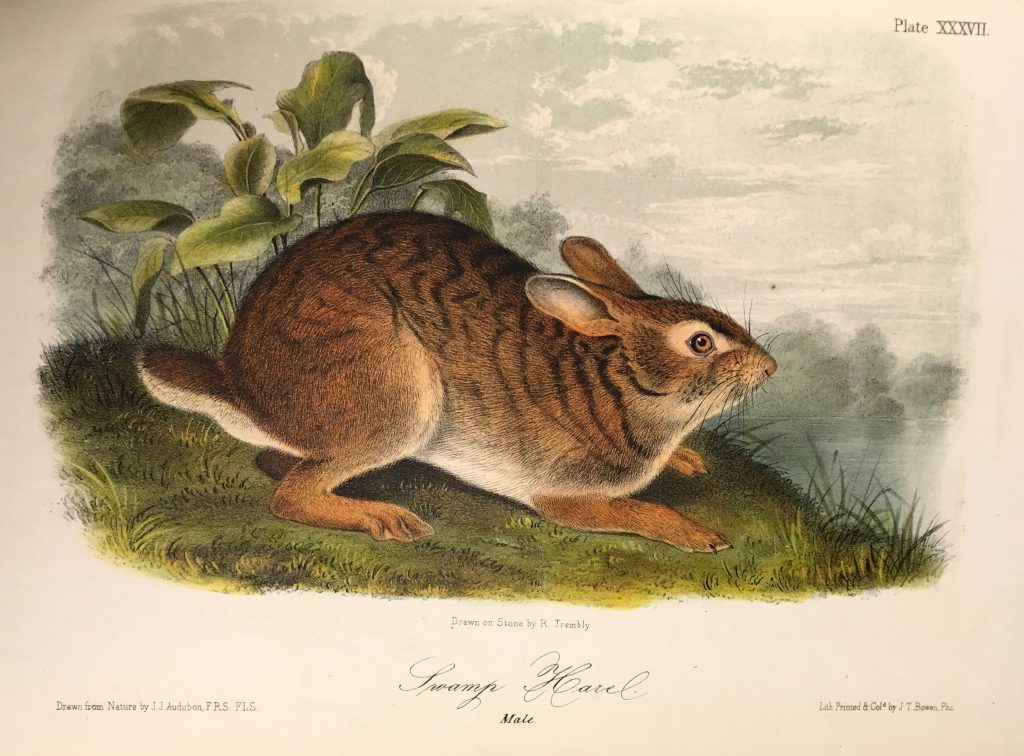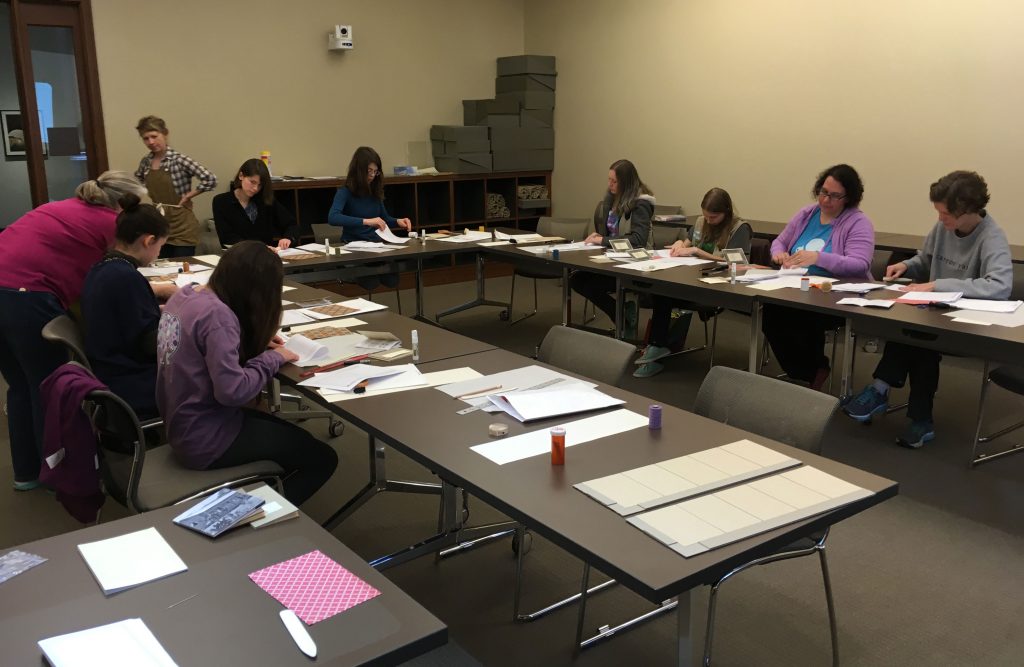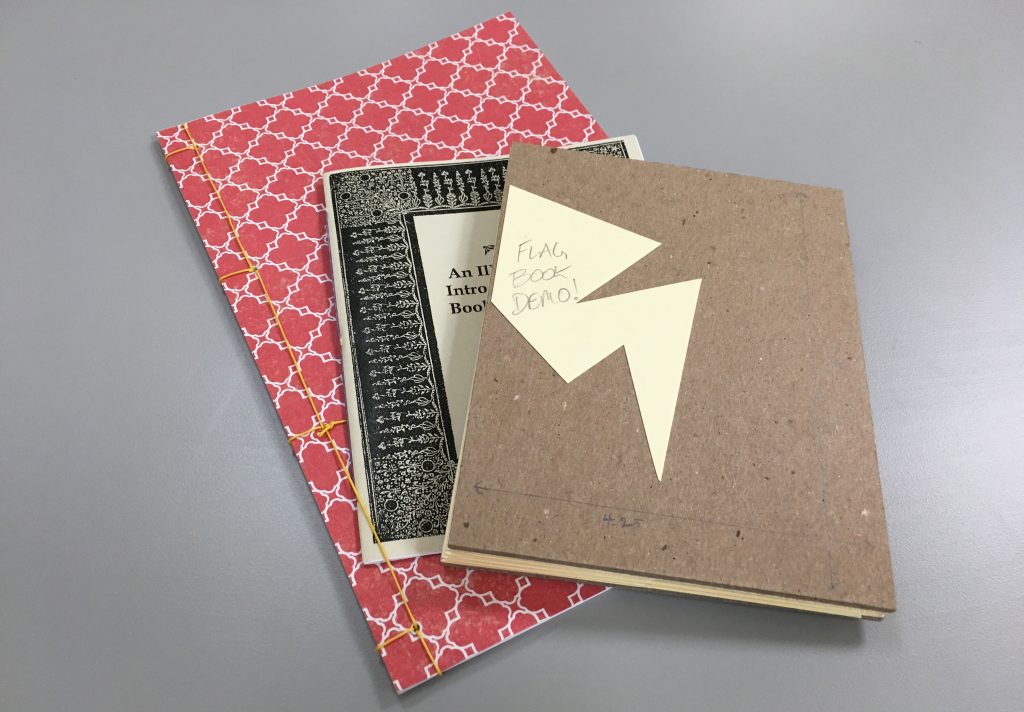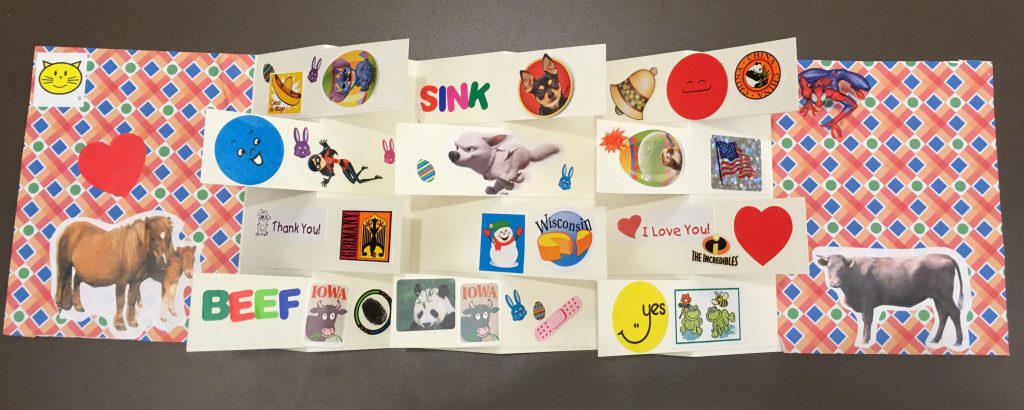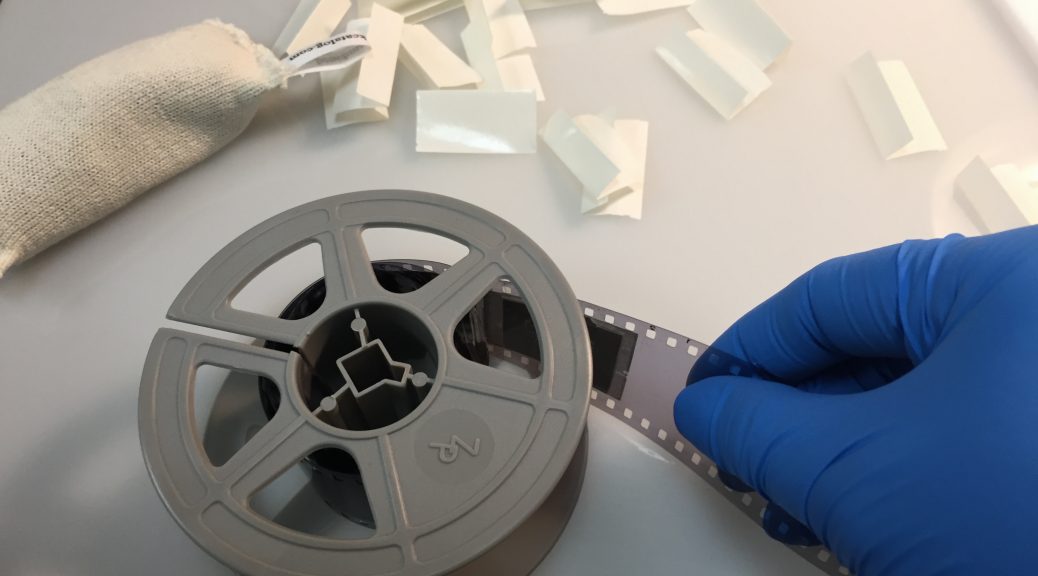Beth is on her way to Chicago for the ALA Annual Meeting, armed with some light reading. You can find a review of Kurlansky’s book here.
Quick Pic: Tape!

This week I’m working on a small collection of newsprint and other printed publications from the NC Mutual Life Insurance Company Archives. This set of materials has been closed to patrons due to some pretty obvious condition issues that make handling risky, but represent some of the few remaining copies of publications from this important organization. This issue of The North Carolina Mutual from August 1903 is, by far, the worst in regard to the amount of pressure sensitive tape that has been applied. I’ve spent the last couple of days just removing tape carriers and reducing adhesive. So far I’ve encountered five (!!) different kinds of tape, all layered on top of one another, in what I’ve started calling a “tape lasagna”. In some places, the original paper support is gone – there is only a hardened bundle of tape.
I’m assuming this item once lived in a 3-ring binder and over time became more and more damaged at the vertical fold and horizontally across the sheet as the pages were turned. I can imagine that over the last 100 years many different custodians took it upon themselves to repair this document and just reached for whatever tapes they had nearby. The earliest (i.e. lowest) tape layer has a glassine carrier, which has darkened a little. Fabric tape was then applied over this to reinforce the binder holes punched along the spine fold. The third layer is tape with a cellophane carrier, which has oxidized and turned dark yellow. Here and there I have found what appears to be a polyvinylchloride film tape and, finally, some more modern cellulose acetate tape at the very top of the heap. I have had to employ a number of different techniques to release each kind of tape, including heated tools, poultices, and solvent chambers. Removing those repairs will take a considerable chunk of time, and some yellow staining still remain. For now, at least, this project feels like a combination of an archaeological dig of office supplies and a jigsaw puzzle.
Quick Pic: When Life Gives You Watermarks
I’m always amazed at what our library collections hold. This absolute gem of a book came to the lab for repair from the general collections, Watermarks In Paper in Holland, England, France, etc., by William Algernon Churchill (reprint of 1st edition; 1967).
Aren’t these watermarks terrific? I love the elephants with their trunks coming out of the top of their heads.

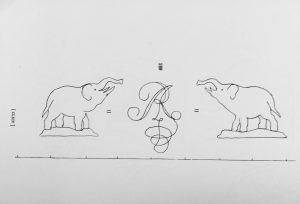

Happy Little Skeleton
Regular readers of this blog may remember when I shared some photos of a fun little copy of the Dance of Death a few weeks ago. The front board had come off, so it was looking a little sad.
It felt a little strange to leave the treatment story of this item unresolved, though. Here are a few more images of the book after treatment.
After firmly re-attaching the front board, I covered the split leather along that joint with a thin, flexible overlay of toned Japanese paper. The leather had been very heavily dressed at some point, and that coating had become quite dark over time. I was able to remove the coating during treatment, which brightened up some of the tooling on the boards and spine.
This little Dance of Death is now ready to head back to its home in the stacks… or to the reading room to remind researchers of their own mortality.
Special Delivery: It’s a Freezer!
When I was a kid, my mother would recite this poem in the springtime when all the new plants and birds started emerging:
“Spring has sprung
The grass is riz
I wonder where the birdies is…”
I don’t know where the birdies are, but we know where our brand new freezer is. It’s been delivered to the disaster supply room. Happy Preservation Week to us!
Easter Bunnies
Today is Good Friday and we happen to have our three-volume octavo edition of Audubon‘s Quadrupeds of North America in the lab to get some stabilizing repairs and enclosures. The first volume of the set is absolutely teeming with prints of hares and rabbits and this seems like an auspicious day to share them. Audubon’s Quadrupeds first appeared in three folio volumes (under the title “The Vivaparous Quadrupeds of North America”) between 1845 and 1848. The first octavo edition was published by John James Audubon’s sons (John W. and Victor) following his death in 1851. Initially both editions were issued in parts. You can view full a full digitized version of this book here.
Quick Pic: When Life Gives You Cephalopods
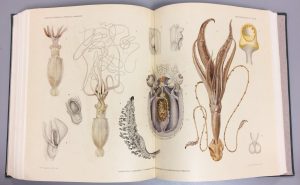 Today was a busy day in the lab. We had 25 people come through on three tours, and we had to help set up for a tour in another department. Today is also the due-date for our performance evaluations. When life gives you a Friday like that, finding a beautiful illustration of cephalopods is a gift. I especially like the center illustration of the eyeballs.
Today was a busy day in the lab. We had 25 people come through on three tours, and we had to help set up for a tour in another department. Today is also the due-date for our performance evaluations. When life gives you a Friday like that, finding a beautiful illustration of cephalopods is a gift. I especially like the center illustration of the eyeballs.
This is one book in a serial on biodiversity. It is French, dated 1889, and beautifully illustrated. Some volumes in this series are available in Hathi Trust. I also found the page on mollusks, which was equally beautiful. This one is getting a custom box to keep it safe.
Merit Badge Workshop
On a recent rainy Saturday afternoon, eight Cadette-level Girl Scouts from three troops around Durham traveled to the Rubenstein Library on West Campus to complete the requirements for their book arts merit badge. The idea for this workshop was given to me by Todd Pattison, a conservator at the Northeast Document Conservation Center, who has been organizing a similar workshop with other Boston-area conservators for several years.
Staff from Conservation Services took turns leading instruction for three different book structures, including a single-section sewn pamphlet, a 4-hole stab binding, and a flag book. To streamline the instruction time, we had assembled kits ahead of time for each student. These included all the materials for each book, pre-cut to size, and the various tools that they would need. We also developed a few simple jigs to make some complicated tasks, like scoring accordion folds or marking sewing stations, a little easier.
As the scouts used simple hand tools to make each binding, they learned the names of each part of the book and how printed pages can be folded down and trimmed to make the book pages.
The highlight of the workshop was the time at the end, in which each girl could decorate her flag book with colored paper, stickers, and markers.
We used the occasion to tour the group around the building and talk about the mission and daily operations of a special collections library. We also brought them down to the conservation lab, so they could learn more about how our department supports the various libraries on campus and to see some of the specialized equipment that we use. This workshop provided a good outreach opportunity for an age group that we rarely see on a college campus. In addition to providing a welcoming introduction to special collections, hopefully the experience also brought some awareness to the possibilities of a career in librarianship or conservation.
Library Conservation is Like a Box Of Chocolates
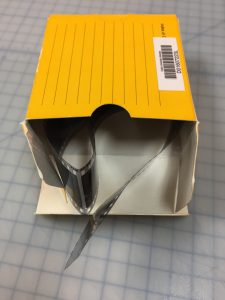 We’ve written about the life of a library collections conservator and how you are often required to know about more than just book conservation. Today was no different.
We’ve written about the life of a library collections conservator and how you are often required to know about more than just book conservation. Today was no different.
I talked with one of the Music Library staff this week. They had a damaged microfilm and wondered if we could fix it. The film had lost its reel, and someone in the past folded it into about six sections and stuffed it back in the box. This caused it to crack at the folds. Luckily we have the terrific Sonya in Microforms who is an expert in microfilm. I asked if she had some splicing tape, and indeed she did. She gave me a tutorial on how to use it along with a roll of splicing tape. Until today, I had never spliced microfilm, nor did I know the sprockets on 35mm microfilm don’t really matter in terms of how the film physically runs the through the machine (unlike motion picture film–the things you learn!).
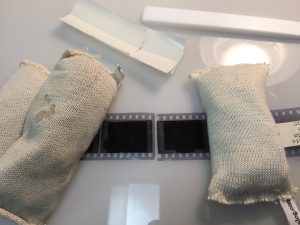 |
 |
|---|
I came back to the lab and carefully eased out the folded sections (who said being a photo major in the ’80’s would never prove useful?). I then matched the pieces and spliced it together at the broken folds. I put the roll on a new reel and sent it back to the Music Library. Hopefully it will run through the reader now without further damage.
 The other thing I learned today was how to change the toner in our copy machine. I’ve never had to do that before today, either. It’s been an amazing day of skill building.
The other thing I learned today was how to change the toner in our copy machine. I’ve never had to do that before today, either. It’s been an amazing day of skill building.
Book Macabre
The other day a pretty somber, but intriguing little book came into the lab.
Just from the decoration, the subject is pretty apparent.
It turns out this is the first authorized edition in Italian of the Dance of Death, printed in 1549 (the binding is from a later period). The book is just one example of a long-standing artistic genre which seeks to remind the reader or viewer that no matter one’s station in life, death comes to us all. The wonderfully detailed woodcuts, designed by Hans Holbein the Younger, depict a personified Death interacting with kings, the clergy, and commoners alike.
This particular volume is interesting because it has been extra-illustrated. Probably at the time it was put in it’s current binding, leaves of thicker wove paper were added to the textblock and engraved copies of the woodcuts were tipped to them. While the designs are sometimes mirrored, it is interesting how faithful the engravings are to Holbein’s original composition.
If you would like to see more of the images, you can view a digitized copy of this book online here. This item will get a few straightforward stabilizing repairs so that it is safe to handle in the reading room. This seems like a good candidate for Rubenstein’s annual Screamfest event in the Fall.














